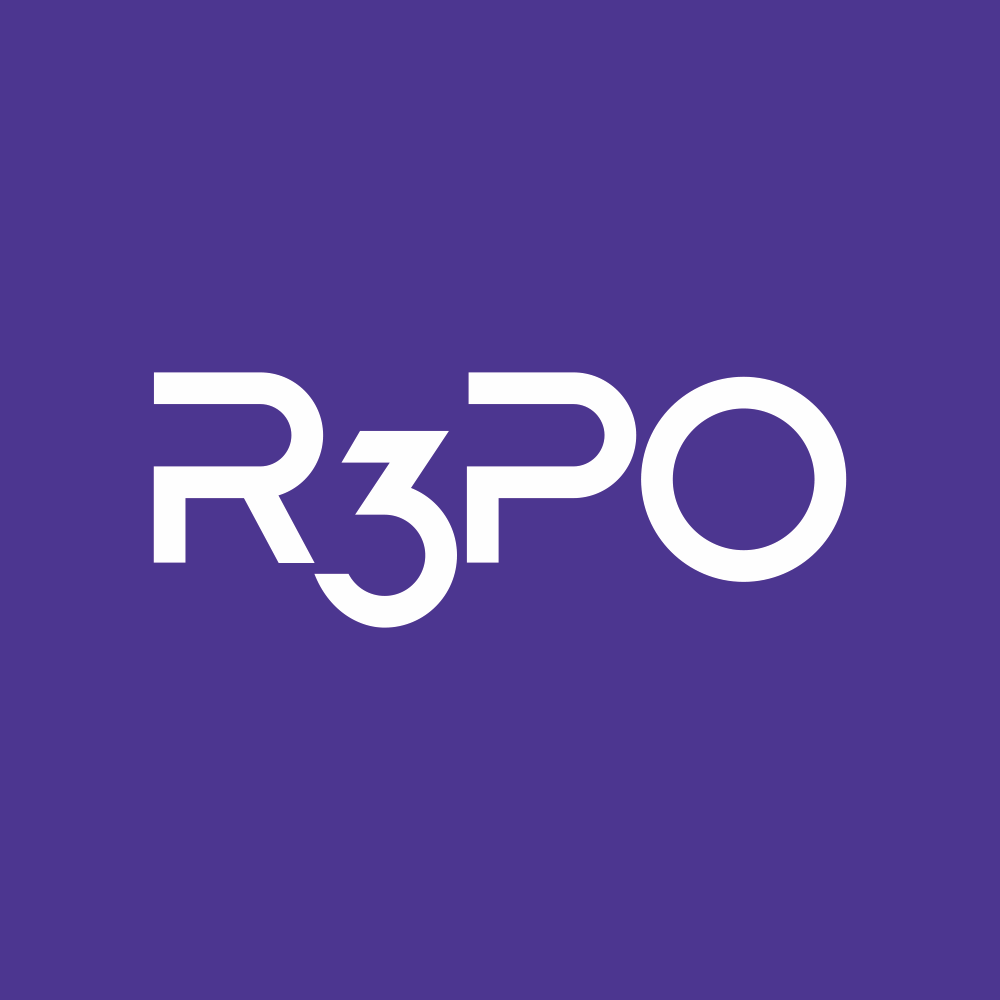The RWA (Real World Assets) narrative has been dormant for the past few years, but recently its taken off. Many traditional financial institutions have begun to lay out the RWA field. For example, JP Morgan executed the first real-time transaction using the tokenized versions of Japanese yen and Singapore dollar on the Polygon blockchain. BlackRock, which holds more than 10 trillion US dollars in financial assets, is Aggressively advancing its expansion into permissioned blockchain space and converting stocks and bonds into digital tokens.
The Citibank report pointed out that almost anything of value can be tokenized, and the tokenization of financial and real-world assets may be the killer application for blockchain breakthroughs. It is predicted that by 2030, there will be 40,000 Tokenized digital securities valued at between US$100 million and US$5 trillion, while trade finance transactions based on distributed ledger technology (DLT) will reach US$1 trillion.
Hong Kong is also looking forward to the development of RWA. In February this year, the Hong Kong Special Administrative Region government successfully issued 800 million Hong Kong dollars of tokenized green bonds under the Government Green Bond Program (Green Bond Programme), which is the first batch of tokenized green bonds issued by the government in the world. According to the analysis of Okey Cloud Chain Research Institute, the development of Web3 and virtual assets in Hong Kong is not only a retreat, but also a pragmatic one. Only by bridging the gap between the encryption market and the real world, enhancing the practical value of virtual assets, and ultimately serving the economic and social development of Hong Kong, can Web3 truly take root in Hong Kong. RWA is an important carrier for connecting virtual assets with Web3 applications and covering the real world, and it is also the most anticipated development direction of Web3 in Hong Kong in the future.
first level title
Part 1 Why the RWA Narrative is Hot
RWA is the physical assets that enter the blockchain through tokenization. These assets can be any form of physical assets, such as real estate, stocks, bonds, commodities, artworks, etc., and tokenize these actual assets on the blockchain , can make these assets easier to circulate, trade and finance, and can also increase their transparency, liquidity and value. According to R3PO analysis, there are two main reasons why the RWA narrative has become popular.
On the one hand, the rise in U.S. bond yields and the sluggish DeFi market have made the encryption industry turn its attention to RWA. The yield of U.S. bonds, which are regarded as risk-free bonds by the market, has risen, and the yield of DeFi has fallen, which has led to the gradual fading of the crypto market boom. Defis total locked value (TVL) has dropped by more than 70% from a high of nearly US$180 billion in December 2021. As of May 6, it had fallen to $48.9 billion.

As market uncertainty increases, DeFi investors increasingly need a diversified portfolio of real-world assets for stable returns unrelated to cryptocurrencies. At this time, RWA has brought new opportunities for DeFi investors. Through blockchain technology, DeFi investors who pursue high returns can enter the traditional off-chain debt market, thereby more conveniently participating in the global financial market.
In fact, from the perspective of the development trend of DeFi, if it wants to develop and grow, it must establish a connection with the real world. By digitizing real-world assets, DeFi can provide its users with a wider range of financial services, thereby promoting the development and innovation of the entire financial industry.
On the other hand, traditional financial institutions have also seen the commercial value and potential of RWA tokenization and began to join this field. Traditional financial institutions hold a large number of real assets, such as real estate, stocks, bonds, etc. The tokenization of these assets can bring higher liquidity and value, thereby increasing the income and competitiveness of the institution. At the same time, RWA tokenization also provides institutions with more investment and financing opportunities, expanding their business scope and market share.
For traditional financial markets, asset ownership and transactions usually need to be certified and supervised by intermediaries, which require a lot of time and cost. The use of RWA can bring tangible benefits to businesses by reducing the need for intermediaries, automating processes, and increasing liquidity.
Taking real estate as an example, the tokenization of real estate assets in the real world can divide the ownership of these properties into several shares, and represent and trade them in the form of digital tokens. In this way, investors can indirectly hold partial ownership of these properties by purchasing these tokens, so as to realize investment and income in real estate assets. At the same time, it can also realize the automatic execution and management of smart contracts, such as automated rent distribution and real estate maintenance, which further improves the liquidity and management efficiency of assets.
first level title
Part 2 RWA track project analysis
The industry is expected to be a $16 trillion market by 2030, as illiquid assets ranging from real estate to carbon credits and natural resources are ripe for tokenization, according to a Boston Consulting Group report.
secondary title
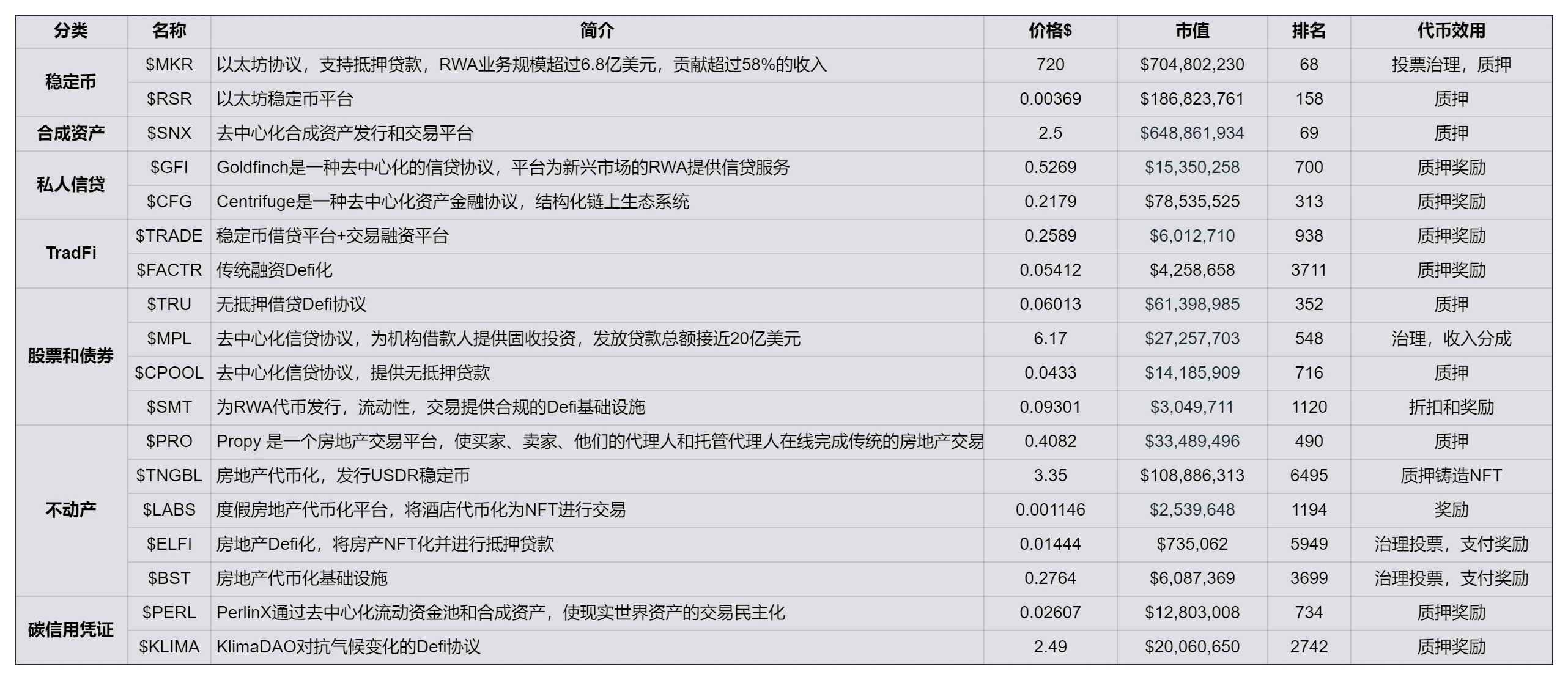
1. Centrifuge ($CFG)-private credit
Centrifuge is a decentralized asset financing protocol. It connects DeFi with RWA while trying to reduce the cost of funding for small and medium enterprises (SMEs) and provide investors with a steady stream of income. The main goal of the project is to generate profits unrelated to volatile crypto-assets, and the developers are pursuing the task of transferring real monetary value from fiat currencies to cryptocurrencies.
secondary title
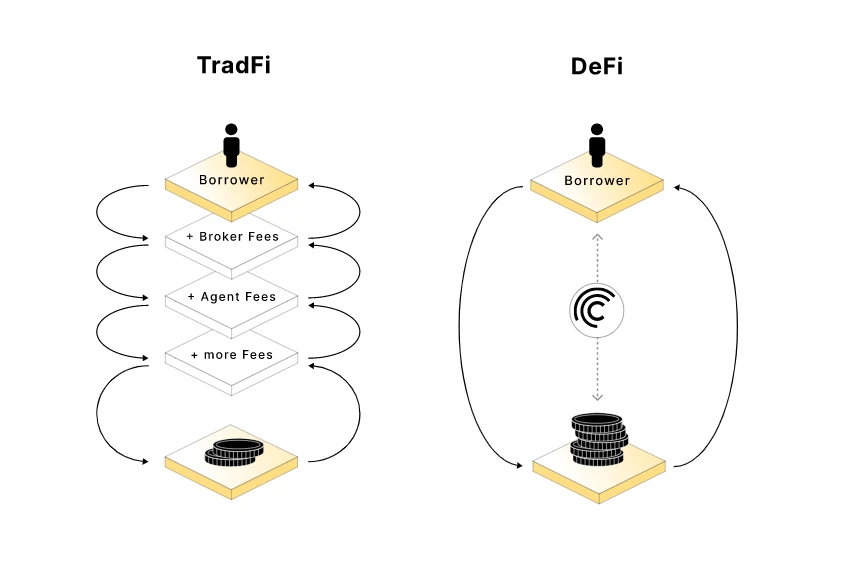
2. MakerDAO ($MKR)-bonds, stablecoins
MakerDAO is an open source decentralized autonomous organization created on the Ethereum blockchain in 2014. Everyone who holds its token MKR around the world can participate in project governance. In addition, MakerDAO issued the stable currency Dai, which supports and stabilizes the value of Dai through a dynamic system of collateralized debt positions (CDP), an autonomous feedback mechanism, and appropriately incentivized external participants.
secondary title
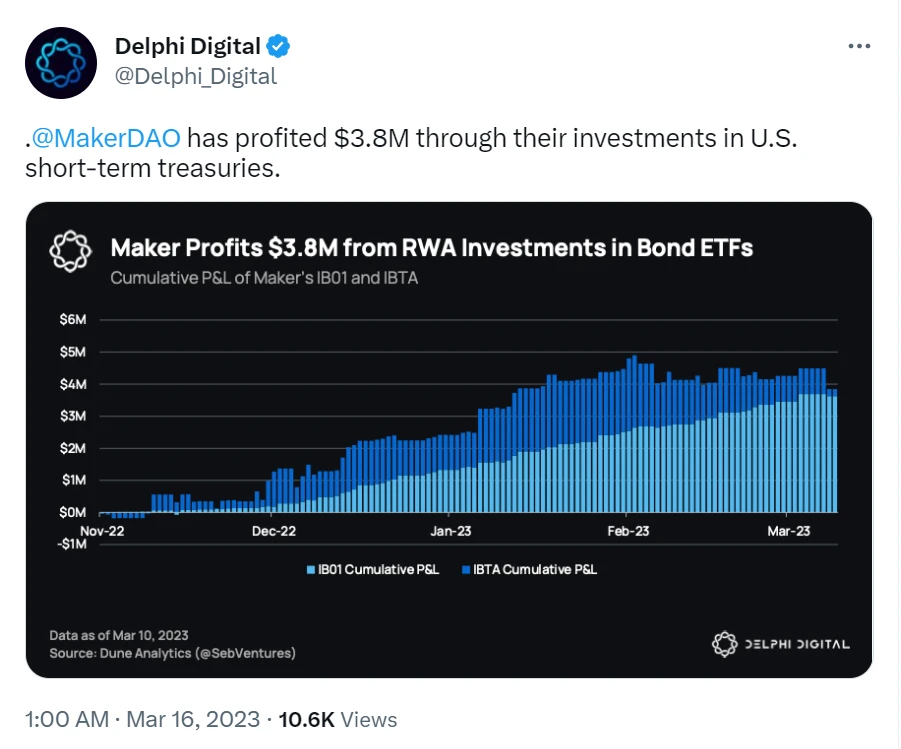
3. Swarm ($SMT)-stock
Swarm, which bills itself as the first tradable stocks and bonds on DeFi, launched in October 2021 and aims to be at the heart of a transparent financial culture that creates value for many. In February 2023, Swarm became the first organization to offer digitized U.S. Treasury bills and Apple stock through a regulated decentralized platform. In the securitys first month on the market, Swarms platform users grew 11 percent and sold out on three separate occasions, with the iShares U.S. Treasury 1-3 Year ETF trading on Feb. It sold out in one day, Tesla stock sold off on February 28, and Apple stock sold off on March 13. Interestingly, the market cap of Apple alone is currently larger than that of cryptocurrencies.
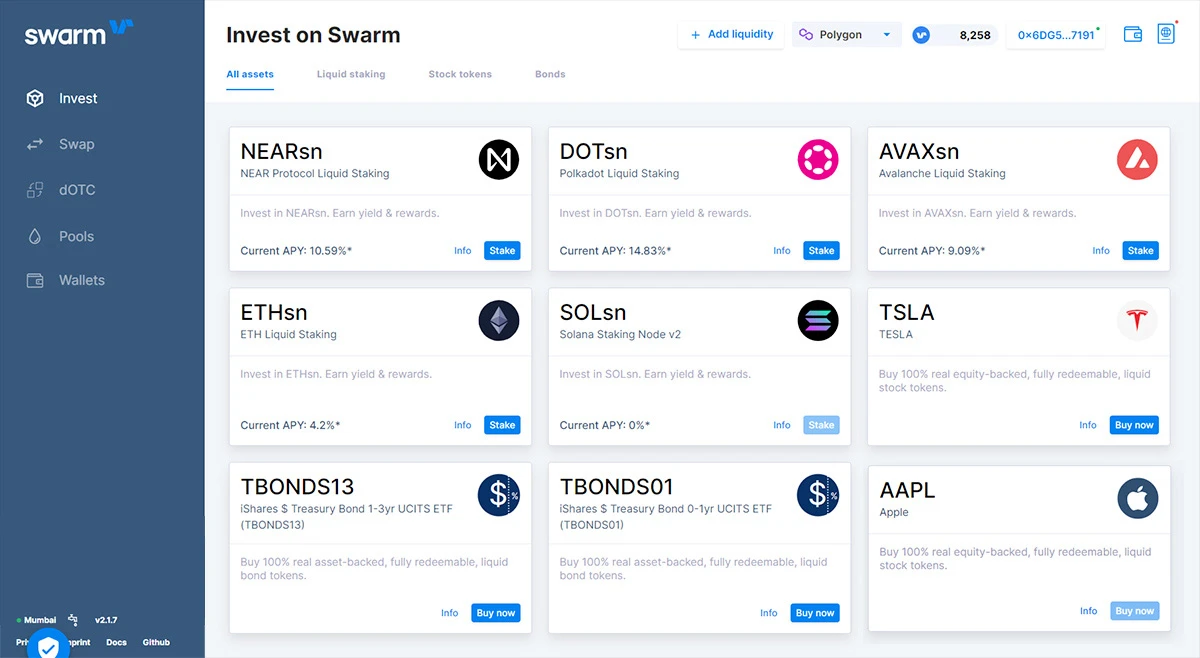
In April, Swarm announced it would add seven more public stocks for retail and institutional investors to trade on its regulated decentralized finance (DeFi) platform. New companies to be listed include BlackRock (BLK), Coinbase (Coin), Kupang (CPNG), Intel (INTC), Microsoft (MSFT), MicroStrategy (MSTR), Nvidia (NVIDIA) and others.
secondary title
4. Propy ($PRO) - real estate
secondary title

5. PERL.eco ($PERL) - carbon credit certificate
secondary title
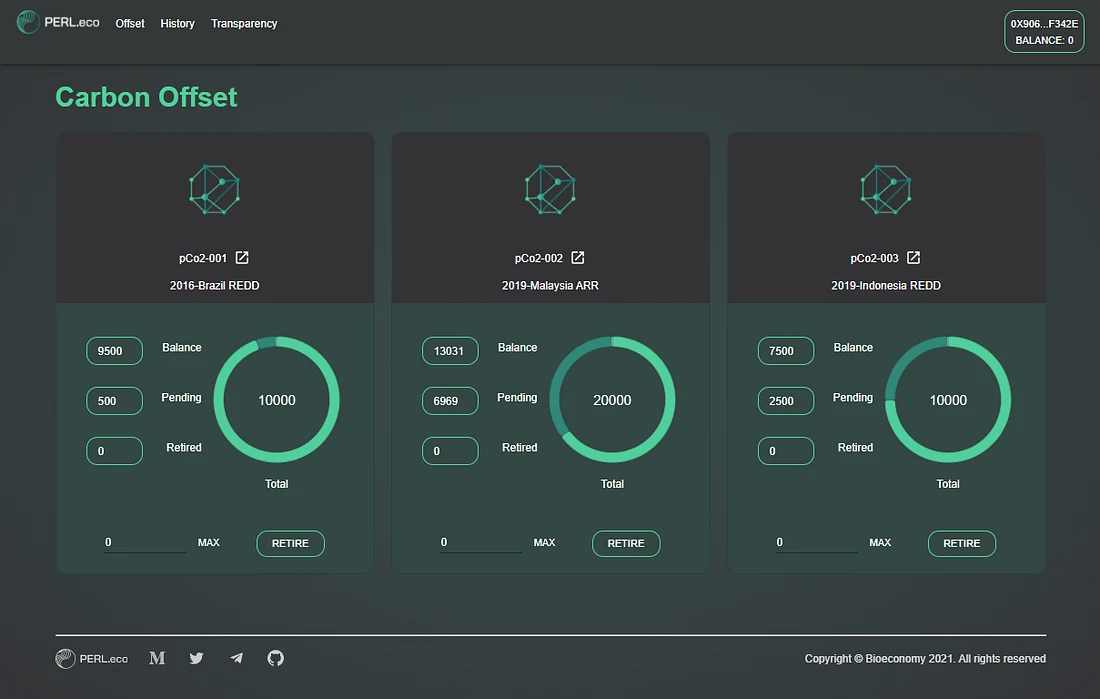
6. Paxos ($PAXG) - metal
epilogue
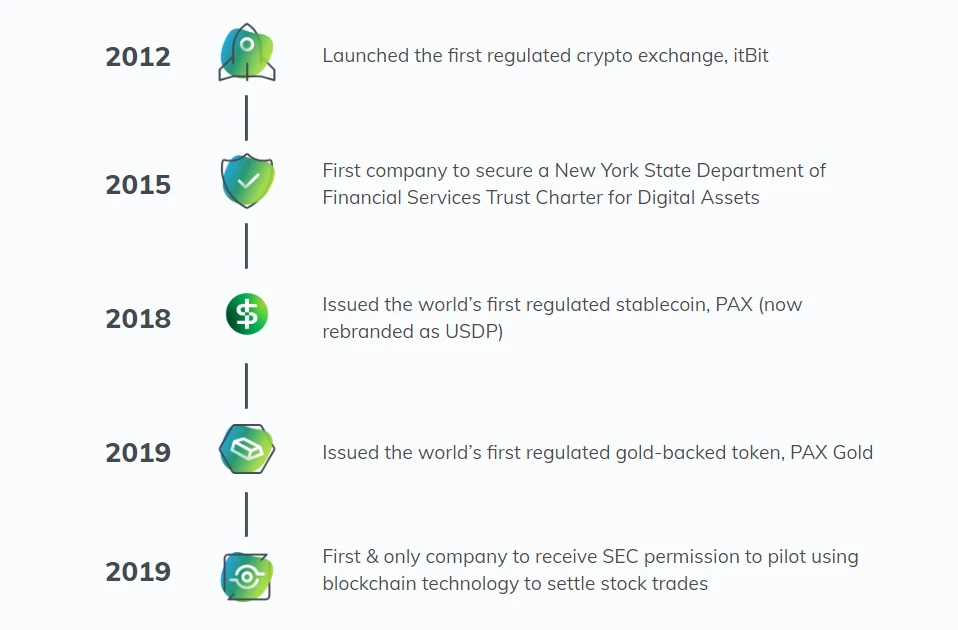
epilogue
The disruptive potential of RWAs tokenized and decentralized financial model to traditional markets cannot be ignored and will show exponential growth in the coming years. The diversification of tokenized asset types provides investors with opportunities for diversification and risk aversion.
However, the legal and regulatory environment of RWA is still uncertain and constantly changing, which has brought uncertainty to investors and issuers. In addition, the liquidity of RWA is also a major challenge, and the DeFi market lacks the resources needed to support large-scale transactions. The depth and breadth of liquidity, which may limit the adoption of RWA, especially for high-value assets. Moreover, the technical infrastructure of RWA also needs to be further improved, including aspects such as security, scalability, and interoperability.
Although there are some challenges and uncertainties in the RWA market, they are still a very promising investment method that can provide investors with diversification and stable investment returns. With the continuous advancement of technology and the gradual clarification of the regulatory environment, the RWA market will further mature and develop. We believe that in the future, RWA will become an important part of the blockchain financial field and have a wide-ranging impact on a global scale.
Copyright statement: If you need to reprint, please add the assistant WeChat to communicate. If you reprint or wash the manuscript without permission, we will reserve the right to pursue legal responsibility.
Disclaimer: There are risks in the market, and investment needs to be cautious. Readers are requested to strictly abide by local laws and regulations when considering any opinions, viewpoints or conclusions in this article. The above content does not constitute any investment advice.

